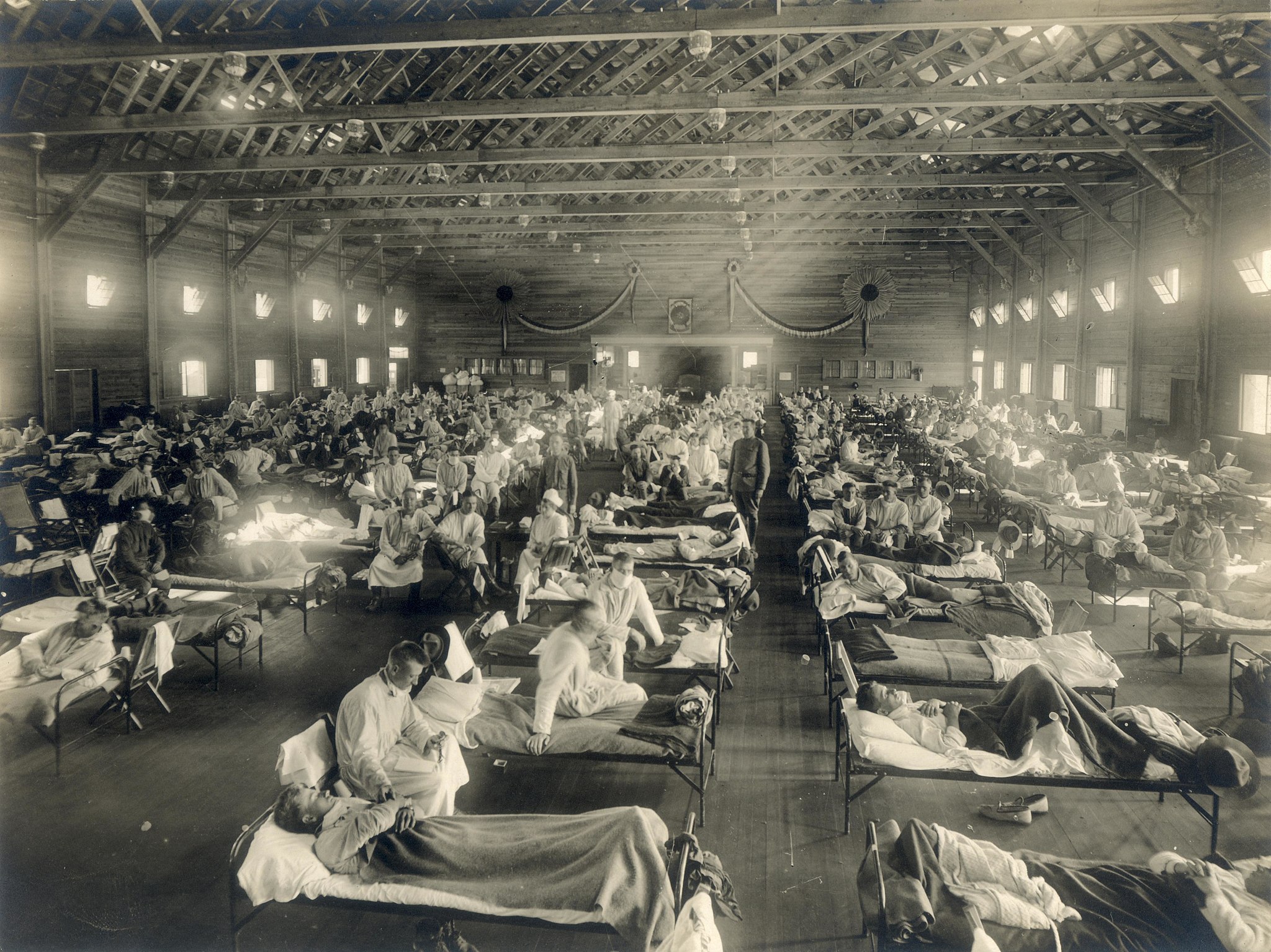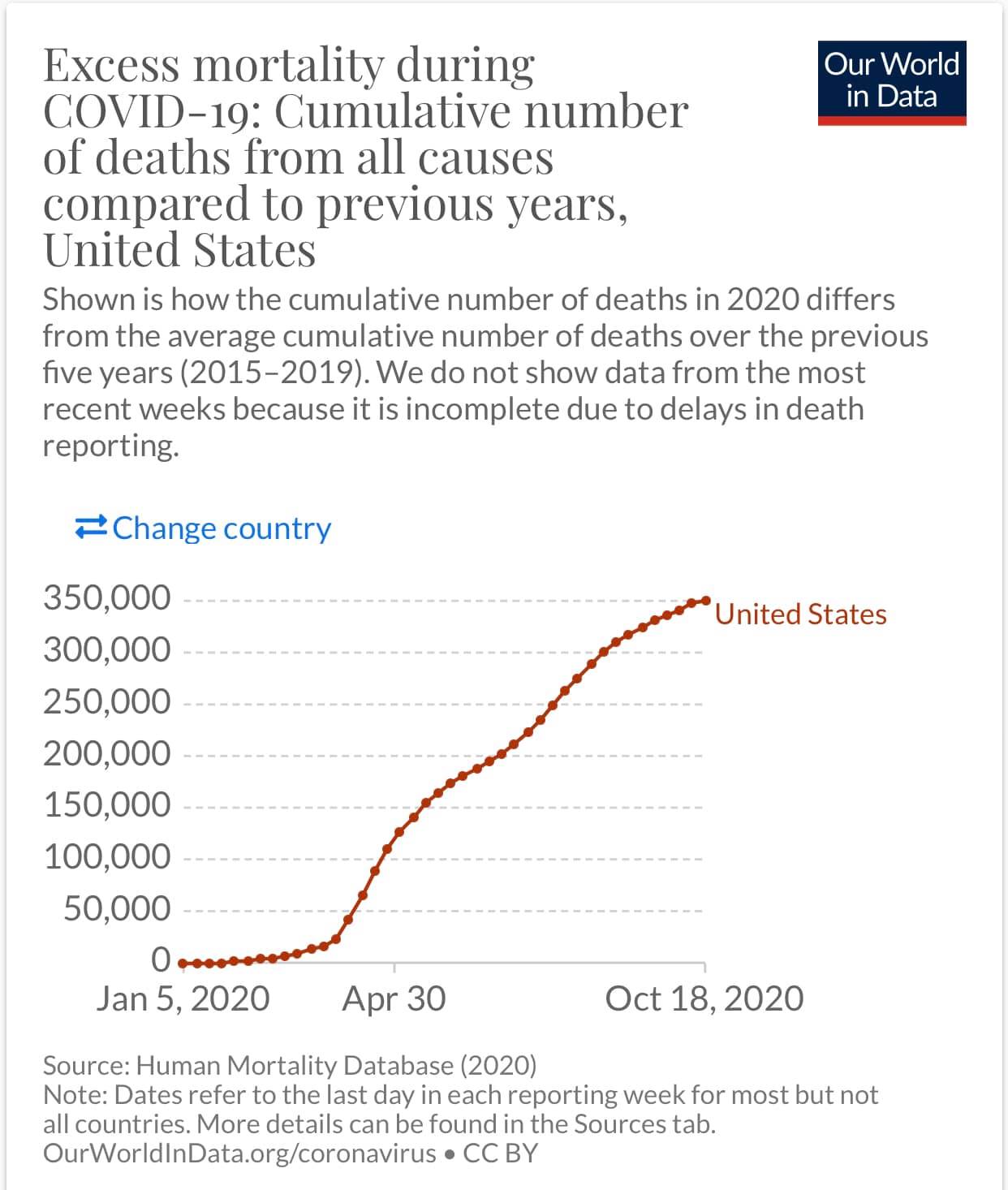COVID vs Flu: Which is worse?

Soldiers from Fort Riley, Kansas, ill with Spanish flu at a hospital ward at Camp Funston. Public domain from Wikimedia
A reader asked me to help them understand whether COVID is different from flu, and why we should care about a disease that 99% of people recover from.
*****
When the SARS-CoV-2 pandemic was recognized in the US back in March, a common argument against efforts to “flatten the curve” was this: We don’t close businesses and schools over seasonal influenza (“the flu”), so why should we over the new coronavirus infection?
Sadly, it’s easier to see now why a stronger public health response against COVID makes sense. Back in March, the absolute number of known coronavirus cases in the US was small, and for a while US COVID deaths were in the tens or hundreds.
As of today, about 270,000 Americans have officially died of COVID. This estimate is low. The number of Americans who have died for any reason in recent months has exceeded the norm by much more than that, according to The Economist excess death tracker. The actual number of US deaths due to COVID (direct or indirect, diagnosed or undiagnosed) may be 1/3 higher than the official number.
How does this compare with seasonal flu?
Unlike the coronavirus (as far as we know), influenza viruses are genetically unstable. They mutate frequently. That means every flu season—every year—the virus can be different enough that a brand-new vaccine is needed. But we do have a flu vaccine every year.
This is one critical difference between seasonal influenza and COVID-19. Even if the flu vaccine isn’t always effective, and despite the fact that an astonishing number of Americans refuse to take it, the flu vaccine saves lives. In particular, the most vulnerable people—the elderly—can get themselves vaccinated against the flu for some protection.
Another critical difference between seasonal influenza and COVID-19 is that most people have some pre-existing immunity. That’s because they have had some kind of seasonal flu in the past, or they have been vaccinated in the past and that may provide a small amount of protection. Across an entire population, small amounts can add up to real effects.
What about mortality?
Flu deaths vs COVID deaths
How many people die from seasonal influenza every year? This is not an easy question because not every patient gets tested for flu, and because influenza infection often leads to death by a different official cause, such as bacterial pneumonia. Therefore the CDC calculates annual flu mortality using statistical models, not death certificates. If they relied only on death certificates that cited influenza, the count would be much lower than the actual burden of disease. (Details here.)
This is in contrast to how the CDC is currently counting deaths from COVID-19. A fatality is only added to the official COVID total if the death certificate reports COVID as a cause of death.
Key point: Official influenza death counts are more likely to be overestimates, and official COVID statistics are more likely to be underestimates, of the actual number of people killed by the virus in one way or another.
With that in mind, the difference between the number of Americans killed by flu and by COVID is even more striking:
Flu-associated deaths, statistical models, US (Source: CDC):
2018-19 34,200
2017-18 61,000
2016-17 38,000
2015-16 23,000
2014-15 51,000
COVID as a stated cause of death, US (Source: CDC):
2019-Dec. 1, 2020 267,000
Again, the official COVID tally does NOT include substantial numbers of excess deaths (CDC data here). Furthermore, the COVID data do not represent a full year. The COVID death toll is rising by one or two thousand every day, so the US toll will soon exceed 300,000, and may end up much higher. In a speech this week, CDC Director Dr. Robert Redfield predicted the next three months will be “the most difficult time in the public health history of this nation.” A US COVID death toll of over 400,000 is entirely possible by March 1.
Taken all together, this suggests that the SARS-CoV-2 coronavirus will kill at least ten times as many Americans as seasonal flu.
If that number is not impressive enough to justify taking strong actions to fight the pandemic, then consider that these deaths are occurring even with lockdowns, social distancing, and crippling economic restrictions. If we had not changed our behavior at all, the alarming early estimates of 2,000,000 potential deaths might have come true.
Are the restrictions justified? Is the cost of our fight against the coronavirus worth the benefits in lives saved?
This is the basic question asked by some people who resist the public health policy in their state or county. I won’t answer it in this blog, because it is a values question, not a science question. How many hundred thousand lives must be at stake to justify the economic and social costs of distancing? You tell me. But I’ll say this: The conversation should be nuanced, and data-based. Some non-pharmaceutical interventions “cost” more than others. Some are more effective than others. We should not be “for” or “against” restrictions, but rather willing to ask which ones are reasonable and which ones we believe are not worth the cost.
Fair-minded people will disagree. But fair-minded people will not claim COVID is a media hoax, or that it is no worse than seasonal flu. Unfortunately, I’m reading that a depressing number of Americans are so mistrustful of our country’s experts, institutions, and media that the numbers I cited above are disbelieved. If you do not believe the CDC reports–if you do not believe the many different private sources of COVID data–if you do not believe that the number of Americans hospitalized with COVID just broke 100,000–then I have no argument to persuade you that at the present time, coronavirus is far more dangerous to society than seasonal influenza. (Individual risk varies.) Perhaps when someone you know dies of COVID you’ll be convinced, but even then a single anecdote cannot convey the national picture. Denialism is so entrenched that the article I linked above tells of a COVID patient in El Paso who continued to blame the media for exaggerating the threat even when he had himself just left intensive care.
By the way, I predict that starting about two years from now, COVID and seasonal flu will indeed be very similar in terms of their impact. That’s after billions of people have gained immunity, and when a vaccine is available to all. The dynamics of an infectious disease change over time as the host population gets exposed.
What about the other kind of flu?
Besides seasonal flu, there is another category of influenza: pandemic flu. Pandemic flu viruses emerge about every twenty-five years. They are more dangerous than seasonal flu because they are the result of a much bigger mutational event called antigenic shift. Pandemic influenza viruses are more different from any flu humans have encountered before, so our collective immunity is not so good. Pandemic influenzas struck the world in 1918, 1957, 1968, and 2009. Some pandemic influenzas are deadlier than others. The 1918-1919 flu pandemic was the worst, killing an estimated 675,000 Americans. (1957: 116,000; 1968: 100,000; 2009: 15,000)
So be careful of any arguments that talk about COVID being “like flu”, because that comparison depends on which influenza virus you’re talking about.
In terms of health impacts,
- COVID-19 is much, much worse than seasonal influenza
- COVID-19 is much worse than some pandemic flus
- COVID-19 is not worse than the 1918-19 influenza pandemic
Final reader question: If something like 99% of people who contract the SARS-CoV-2 coronavirus either have no symptoms at all or recover quickly, why not let the virus run its natural course?
That answer is easy. If only 1% of people have a bad outcome or die of COVID, those are excellent odds for the individual but terrible for society as a whole. While I might be comfortable with my personal risk, if the virus is left completely unchecked, over a million Americans would die because there are 328 million of us.
For this reason, if you argue that we shouldn’t worry because COVID recovery is greater than 99%, you must acknowledge that a lot of people will nevertheless die because 1% of a large number is still a large number.
Questions? Contact me.
Amy Rogers, MD, PhD, is a Harvard-educated scientist, novelist, journalist, and educator. Learn more about Amy’s science thriller novels, or download a free ebook on the scientific backstory of SARS-CoV-2 and emerging infections, at AmyRogers.com.



